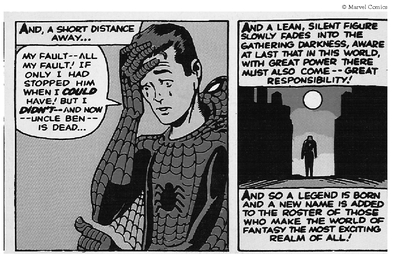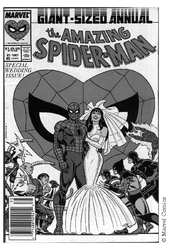5
SPIDER-MAN
In Amazing Fantasy #15, the very last issue of the series, Peter Parker, the Amazing Spider-Man made his debut. Very quickly, he gained his own magazine, and soon after that, he was not only the single most popular Marvel character, but he was one of the most popular comic book characters period, rivaling the popularity of even Batman and Superman.
Amazing Fantasy #15 was written and drawn by Stan Lee and Steve Ditko, and the pair would team up to produce a notable thirty-eight-issue run of the ongoing Amazing Spider-Man title, during which time they would introduce pretty much every notable Spider-Man supporting character and villain, including Doctor Octopus, the Green Goblin, Aunt May, and J. Jonah Jameson.
The Spider-Man series was notable for the time because of how much of an everyman Peter Parker was—this was not some millionaire playboy, nor was he a successful reporter. He was a young adult trying to make his way in the world and failing as often as he succeeded. His trip to becoming a hero was filled with the sort of tragedy that makes great men. After being bitten by a radioactive spider, Parker gained remarkable abilities. Rather than use these powers for good, he first uses them to become an entertainer, and when a crook runs by him, chased by the police, Peter does nothing to stop him. Later, however, he learns the folly of his ways when that same crook murders his beloved Uncle Ben. From that moment on, he resolves to use his powers for good, in honor of Uncle Ben’s memory.
Spider-Man was soon popular enough to have both his own animated series (with a notable theme song: “Spider-Man, Spider-Man, does whatever a spider can”) and be one of the first Marvel characters to receive a spin-off title. At one point in the 1990s, Spider-Man was juggling four monthly titles, a distinction shared only with Batman and Superman.
In 2002 Spider-Man made the leap to the big screen, in one of the most successful film franchises in movie history, setting box-office records with the first film that were broken by the second film. Currently, there are plans for a fourth Spider-Man film, although details have not yet been released.
AS TOUCHED ON earlier with the creation of Batman (see pages 33-34), sometimes identifying who should be considered the “creator” of a fictional character can be extremely difficult. If an editor tells a writer, “Write me a character involving turtles,” and that writer creates Turtle-Man, who is the creator? Couple such loosely defined creatorship with an artist with an often poor memory and a bit of ill will, and you get a situation like Jack Kirby claiming that he and Joe Simon were the creators of Spider-Man.
Joe Simon and Jack Kirby had a long-lasting partnership, from their days at Timely in the 1940s, where they created Captain America, to their days at DC, where they produced one of the company’s most popular wartime comics, Boy Commandos, to their independent days, when they cocreated the very first romance comic book. By the mid-1950s, however, comic sales had slowed to the point where it was not economically feasible for the two to shop themselves as a pair, so they split up, with Simon going to work in advertising and Kirby going to work at DC Comics.
The pair had one last hurrah, though, in 1959, when the publishers at Archie Comics, just like Martin Goodman at Marvel Comics, saw that DC was having success bringing back its superheroes. Archie enlisted Simon to launch a line of superhero comics, and Simon turned to his former partner for the project. Among the concepts they worked on was a hero they had discussed a few years earlier called the Silver Spider. The Silver Spider was a young boy who wished upon a ring he found in a magical spider web and was transformed into the adult superhero the Silver Spider, who would fight crime with a gun that would shoot webs (similar to the web shooters that Spider-Man wears around his wrists). At the time, Jack did not like the name Silver Spider and suggested they use the name Spider-Man. Simon even worked up a mock logo for the title. While they abandoned the project then, they brought it back up when Simon was given the call from Archie to do the new line of superheroes. Ultimately, Simon would change the name of the character to the Fly, but otherwise the concept stayed the same. Kirby drew the series, which, like the other titles in the Archie line of super-hero comics, did not last long (although the Fly did survive for thirty issues).
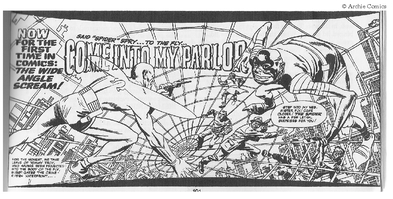
Fast-forward a few years, and Stan Lee is looking for a teen superhero for Marvel Comics. He asks Kirby to come up with some ideas, and Kirby remembers the Silver Spider/Spider-Man story and pitches it to Lee. Lee is interested and asks Kirby to work up a proposal. Lee determined that the superhero Kirby came up with was too traditional, so he gave Kirby’s proposal to Steve Ditko, who remarked to Lee that the premise sounded an awful lot like the Adventures of the Fly series from Archie. Lee concurred and asked Ditko to change it around, so Ditko eliminated the web gun, the costume, and the whole wishing-upon-a-ring premise, leaving the character as Peter Parker, the Spider-Man readers know and love.
So who created Spider-Man? After years of disputes with Marvel, Kirby at one point claimed that he created Spider-Man, but Kirby’s memory was not always the greatest, and he would tend to go along with whomever he was talking to at the time. If the interviewer said something like, “So you created Spider-Man?” Kirby wouldn’t contradict him. However, when asked about it later, Kirby clearly stated that he considered Ditko to be the man who developed Spider-Man. Stan Lee agrees, and ultimately, that is likely the fairest call, although it sure makes for an interesting argument.
AN INTERESTING ASPECT of the human memory is that it can often play tricks on us, making us remember hearing what we never actually heard. For instance, during the three seasons of the original Star Trek television program, Captain Kirk never says, “Beam me up, Scotty.” Never in Casablanca does Rick tell Sam to “Play it again, Sam.” We think we heard those phrases said, so we remember them being said. A similar situation occurs with Amazing Fantasy #15, which is famous for the quote from Peter Parker’s Uncle Ben, “With great power, comes great responsibility.” He never actually says it in the comic.
The phrase itself has an interesting history in the sense that no one has been able to determine definitively where Stan Lee came up with it. It is certainly possible that Lee came up with the line on his own, but is seems more likely that a line that classic was most likely taken from some older source. No one has yet definitively identified the quotation, although there have been many famous quotes that mirror the intent of the phrase, including Winston Churchill’s “the price of greatness is responsibility.” And presidents Franklin and Theodore Roosevelt both came close. Franklin: “Today we have learned in the agony of war that great power involves great responsibility.” Theodore: “I believe in power; but I believe that responsibility should go with power.”
In any event, while Peter credits this philosophy (which is the central theme behind his being Spider-Man) to his Uncle Ben Parker in later issues, and in the films the Uncle Ben character says it to Peter, Uncle Ben never actually says it in Amazing Fantasy #15. Instead, after Peter delivers Uncle Ben’s killer to the police, as he realizes that Uncle Ben would still be alive had he acted responsibly in stopping the crook when he had the opportunity, Peter walks away while a caption box says: “And a lean, silent figure slowly fades into the gathering darkness, aware at last that in this world, with great power there must also come—great responsibility!”
So Spider-Man learned this lesson in his first issue, but he did not learn it from his Uncle Ben.
ONE OF SPIDER-MAN’S greatest enemies is the Green Goblin, who is the main villain in the first Spider-Man film. The relationship between Spider-Man and Green Goblin is poignant—Spider-Man knows that the Green Goblin is Norman Osborn, father to his best friend, Harry, but neither Harry nor Norman know the truth (the split-personality Norman becomes the Green Goblin during psychotic breaks). It is an interesting dynamic, but a dynamic that Spider-Man cocreator Steve Ditko was strongly against.
When he debuted, the Green Goblin was a total mystery, even to the readers. This was not the first time that Stan Lee and Ditko had introduced a villain with a mysterious identity that was revealed after he had been a thorn in Spider-Man’s side for a time. In the early 1960s, there was a mysterious villain trying to take over the New York mob. He was known only as the Big Man. Eventually, his identity was revealed to be Frederick Foswell, a reporter that Peter Parker knew from his job as a photographer for the Daily Bugle.
Ditko seemed to be fine with this revelation, but when it came time to reveal the secret identity of the Green Goblin, he and Lee disagreed vehemently over who the Green Goblin should turn out to be. Ditko argued that it simply did not make sense that the Green Goblin, a criminal with absolutely zero ties to Spider-Man before Spider-Man starts trying to keep the Goblin from committing crimes, would just happen to be someone that Peter knew in his real life. It was one thing for one criminal mastermind to be someone Peter knew personally, but another? Ditko felt that it strained the readers’ suspension of disbelief to the breaking point.
Lee, on the other hand, felt that if you were going to spend the time to build up to revealing a major character’s identity, you simply could not have it be someone who no one has ever seen before. Yes, it would be more realistic if Spider-Man pulled off the Green Goblin’s mask and said, “Who are you?!” But since this is already a comic book where the hero dresses in red and blue tights and has powers like a spider, realism is not the main priority.
Whichever argument was more convincing, the point was made moot when Ditko left the title with Amazing Spider-Man #38. In the next issue, Green Goblin was revealed to be Norman Osborn.
STEVE DITKO’S DEPARTURE from The Amazing Spider-Man is one of comic’s greatest mysteries while being at the same time not so much a mystery at all.
The mystery is, why did Steve Ditko leave Amazing Spider-Man? And it is considered a mystery because Ditko both (a) does not do official interviews and (b) has made statements in the past to the effect that his reasons are his own, and he won’t tell anyone what they are. This was actually the basis for a recent BBC documentary by Jonathan Ross, which tried to get a definitive answer from Ditko on the topic. So yes, if not having a definitive answer from Ditko qualifies as something as an unsolved mystery, then this would be a mystery. However, there is enough information out there that Ditko’s reasons for leaving are not really that mysterious. It is more a question of what specific straw broke the camel’s back.
Ditko’s experiences in many ways echoed Jack Kirby’s on the Fantastic Four. In both cases, the attention in the media was spotlighted on Stan Lee more than it was on either Ditko or Kirby. This was partially because of Lee’s engaging personality, partially because he was the editor in chief of Marvel and therefore more public of a personality, and partially because Lee was the one common element between the various notable creations. So it would appear that he was the x factor. As with Kirby on The Fantastic Four, as Spider-Man went on Ditko did more and more of the writing. In 1964, about a year and a half before quitting, Ditko made a bold request from Marvel that certainly seemed to highlight his displeasure with his current situation. He wanted credit as the plotter of the book; he wanted the extra money that would come from being at least the cowriter of the comic; and, most notably, he did not want to have to speak to Stan Lee at all. The Amazing Spider-Man was a good seller, so Marvel made the deal, but when one asks specifically not to have to talk to his cowriter/editor, it certainly does not bode well for his future on the title, does it?
Meanwhile, while Ditko and Lee were not speaking, Ditko was still consistently angry over Lee’s writing for Spider-Man. Just as the two differed over how to handle the revelation of the Green Goblin’s identity, Ditko was also upset over how Lee saw Peter Parker, period. Ditko was an objectivist, a follower of Ayn Rand, and he believed people were either good or evil, so he was bothered that Lee consistently portrayed Peter Parker as what Lee considered an “everyman,” someone who had bad sides to his personality as well as good. Ditko wanted Parker to be a clearly defined good guy.
Around that same time, Stan Lee was purposely having Spider-Man guest star in the pages of Daredevil to see how artist John Romita would be able to handle Spider-Man if need be, so it is not as though Lee was not already planning for a world without Ditko.
Soon before Ditko quit, Marvel announced that it was releasing a series of animated television adaptations of its comics, and the cartoons would actually be roughly animated versions of the comic drawings. While Spider-Man was not part of this first wave of animated programs, it was clear that he would soon be featured on a television program too (and he was, the following year), so Ditko would be working on a book with a man he was angry at (to the point of not even speaking to him), in which he disagreed with how the main character was being portrayed, while also knowing that a character he helped create was most likely going to be turned into a television program from which he would not make any money.
Is it really a mystery, why he quit? Ultimately, it really does not matter what specific occurrence broke the proverbial camel’s back—he clearly had more than enough reasons to quit.
AS MENTIONED (see page 67), the Comics Code Authority had strangely strict guidelines for what was allowed in comics. Sometimes these seemed to run counterintuitive to the messages one might think people in positions of authority would want to deliver to children. Never was this more evident than with the story line for Amazing Spider-Man #96 through #98 in 1971.
In the early 1970s, the United States Department of Health, Education, and Welfare approached Stan Lee. It requested that he write a story line in Amazing Spider-Man addressing drug use. The department felt that Spider-Man (one of the highest-selling comics in the industry) would be an excellent platform for getting an antidrug message across to children. Lee was willing to go along with the request, but he was hamstrung by a simple rule set down by the Comics Code Authority: you could not have drug use in a comic, no matter how it was depicted. Marvel approached the Comics Code Authority with the information that they were specifically requested to do the comic by the U. S. government. However, the Comics Code Authority refused to bend on its position. In a bind, Lee approached Marvel publisher Martin Goodman and asked permission to bypass the Comics Code for this story line. Goodman approved, and for the first time since the code was created, a comic book appeared without its seal of approval.
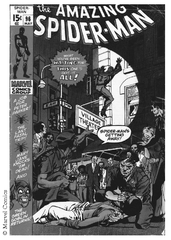
While it was a big risk, and it could have led to the comic not being sold in a number of locations, the sales for the issue were fine, and Lee ultimately got more praise for it than criticism. This finally led the Comics Code Authority to overhaul its guidelines and allow story lines with negative depictions of drugs.
Soon after the code overhaul, DC did a story line in its team-up title Green Lantern / Green Arrow with a dramatic drug-related plot. In the Spider-Man story, Spider-Man’s best friend, Harry Osborn, has a problem with pills. What sort of pills Harry was using, the reader does not know, but we know that they’re bad! In the Green Lantern / Green Arrow story line, Green Arrow’s teen sidekick, Speedy (appropriate name, no?), is feeling neglected by his mentor, so he turns to using heroin!
DC had its more dramatic story planned first, but DC editorial did not want to run afoul of the Comics Code, so it held off on the story. Then Lee’s issues came out, and within a few weeks, the rules were changed and DC was free to publish its story line. The book proudly proclaimed on its cover that it was going to be about drugs, while the Spider-Man issues gave no indication, save for the lack of Comics Code approval on the cover.
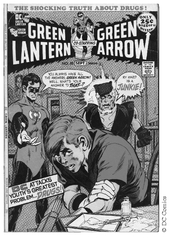
THE AMAZING SPIDER-MAN comic strip, which is ostensibly written by Stan Lee (whether it is ghostwritten is a whole different story) and illustrated/cowritten by Stan’s brother, Larry Lieber, is probably the most successful superhero comic strip ever. It has been in print since 1977, which is an impressive tenure during the days when adventure comic strips are a dying breed. Its circulation is not as high as it once was, but it still appears in a number of papers. Luckily for law-enforcement officials, though, it still ran in New Mexico newspapers in the late 1970s, where it inspired the invention of electronic monitoring bracelets.
The idea of monitoring bracelets had been around for years in the world of animal tracking: scientists would clamp little ankle bracelets on to animals so they could keep track of their migration patterns. In the 1960s, some researchers at Harvard University considered the application of this technology to monitoring criminal offenders, but it did not get past the academic level. In a Spider-Man comic strip tale during the late 1970s, the villain Kingpin placed an electronic device on Spider-Man’s ankle, which he used to monitor him. The strip writer (Lee, at that time) was certainly thinking of the bracelets they put on animals.
Well, a New Mexico district court judge, Jack Love, read the strip and theorized that such a device would work in real life as well. Love struck up an arrangement with Michael T. Goss, a former Honey-well computer salesman, who developed the devices. They were first tested in New Mexico in 1983. The tests went well, so they expanded the devices for use in Florida. These tests were also successful, and within six years, the devices had spread to a number of states. Nowadays, over one hundred thousand ankle monitors are used daily in the United States alone.
IN a RECENT story line in the Spider-Man comic book series, Peter Parker, who had been married in the comic books to Mary Jane Watson since 1987, had his marriage erased from existence by a supernatural character. Fans howled over the idea that simply because Marvel editorial felt Spider-Man should be a single hero they were willing to force the character to be single in the comic books (though he was married in the comic strip). However, most fans forget that the reverse happened in 1987 when Spider-Man was forced to get married despite the wishes of the comic book creative staff.
It is still disputed who came up with the idea, Stan Lee himself or Marvel editor in chief Jim Shooter. But in any event, one of the two came up with the idea that Peter Parker should marry his longtime sweetheart, Mary Jane Watson, in the Spider-Man comic strip, and then, to make it a bigger deal, they should coordinate the marriage with the comic books and make a public-relations sensation out of the wedding.
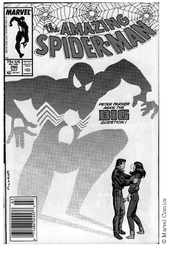
The problem in the comic strip was that while Peter and Mary Jane had dated in the past (Peter had even proposed in the late 1970s), Mary Jane turned him down and left town. The current Amazing Spider-Man comic book writer, Tom DeFalco, had recently brought Mary Jane back as a supporting cast member (along with the revelation that she had secretly known Peter’s identity as Spider-Man since they were both teenagers). But he had even more recently written Mary Jane out of the book. So Mary Jane not only had to make an abrupt return to New York in the comics, she and Peter had to get back together and get engaged, in the span of about three issues of the comic book, Amazing Spider-Man #290 through 292 (see pages 20-21 for the Superman version of this story).
The end result was The Amazing Spider-Man Annual #21 in 1987, which was released at the same time that The Amazing Spider-Man comic strip was also featuring the wedding. In addition, a “wedding” was held at Shea Stadium, before a New York Mets game, between two actors dressed as Spider-Man and Mary Jane. Stan Lee was the justice of the peace presiding over the ceremony.
So yes, twenty years later, Marvel editorial determined it was going to go the other way and have Spider-Man’s marriage erased from existence, but it was only undoing the order imposed on it in 1987. Note that in the ongoing comic strip Peter and Mary Jane are still married.
VENOM, WHO WAS recently featured as the villain in the film Spider-Man 3, has an interesting lineage as a character. In the early 1980s, Spider-Man received a new black costume that turned out to be, in fact, an alien life form. The alien wanted to bond with Spider-Man, but the superhero managed to free himself of it. It sought out another host, ending up with a reporter named Eddie Brock whose career had been ruined when Spider-Man brought to justice a costumed villain that Brock had earlier identified as a different man entirely. The merged entity, calling itself Venom, became a frequent rival of Spider-Man over the years (and so popular that he even gained his own title for a while).
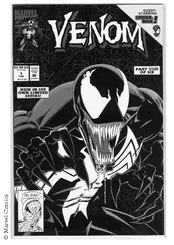
However, things could have gone in a completely different direction if creator David Michelinie had gone with his original instinct, which was to make Venom a woman. The origins of the character would be fairly similar; it would still be someone who harbored a grudge against Spider-Man and would merge with the alien life-form. Michelinie’s original idea was to involve a pregnant woman who was rushing to the hospital with her husband to deliver her baby. They would be hailing a cab in the middle of New York while Spider-Man was fighting a super villain. A cab driver, distracted by the fight, would accidentally run over the woman’s husband. He would die in front of her just as she goes into labor. She would end up losing both her child and her sanity at the same time. After she got out of a mental institution, she would harbor an intense hatred for Spider-Man, making her a perfect host for the alien costume. When Michelinie pitched the idea to Amazing Spider-Man editor Jim Salicrup, however, Salicrup felt that readers simply would not believe that a woman could be the physical threat that Venom needed to be, even a woman with enhanced alien strength.
Michelinie went back to the drawing board, and the classic form of Venom was born.
AS MENTIONED, THE comic book story line about Spider-Man’s new black costume turning out to be an alien and then becoming the new villain Venom was the centerpiece of the plot of Spider-Man 3. It’s interesting to note, however, that had it not been for a comic fan who never had a single comic book story published, the whole story line would likely never have existed.
In 1982 a young comic fan named Randy Schueller heard that Marvel was having some sort of competition for aspiring comic book writers and artists (the competition was published in 1983 as The Official Marvel Comics Try-Out Book), so he sent in a story idea. His concept was that Spider-Man would consider upgrading his costume, so he would go to Mr. Fantastic to help get a suit that was stronger than his cloth one. Along the way, he would decide to make the new costume all black. Marvel editor in chief Jim Shooter liked the idea enough to buy the story from Schueller for $220, and he would even allow Schueller the opportunity to write the story!
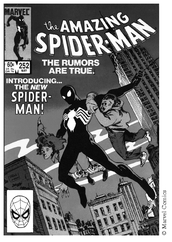
He assigned Schueller to Marvel writer-editor Tom DeFalco, who worked with the young writer for a couple of drafts of the story that ended up going nowhere. The story went to the scrap heap, and Schueller moved on with his life. Well, a year later Shooter was producing a major crossover starring all the Marvel superheroes, called Secret Wars. Shooter wanted to have a few notable changes happen to most of the characters (for instance, the Thing leaves the Fantastic Four and is replaced by She-Hulk), and remembering the black costume idea, decided that Spider-Man would get a new costume in the course of the series.
Spider-Man’s new black costume was quite a sensation at the time, and, as mentioned, the revelation that the costume was actually an alien led directly to the creation of one of Spider-Man’s most popular villains, Venom, who had his own series for almost four years and became the basis for a tremendously popular motion picture sequel.
All that for $220—quite a value!
IN 1998 TOM DeFalco introduced a new superhero, May “Mayday” Parker, known as Spider-Girl, the daughter of Spider-Man. She originally appeared in a What If . . . ? comic book (a Marvel title that explored various possible futures, like, “What if . . . Spider-Man had a daughter who grew up to become Spider-Girl?”), but Spider-Girl soon became the centerpiece of a whole line of comics (headed by DeFalco) depicting the sons and daughters of famous Marvel characters. Within a year or two, all the other titles in the line were canceled, leaving Spider-Girl as the only survivor. Surprisingly, the book kept going.
Spider-Girl flirted with cancellation a number of times, though, and ultimately, after around three years of publication, Marvel determined that the book would be canceled. Then something interesting happened: Marvel editor in chief Joe Quesada received a fan letter from a little girl, pleading with him not to cancel Spider-Girl, because there were so few superhero comic books for little girls to read, and Spider-Girl was her favorite. The idea that this particular comic appealed to a demographic that Marvel’s other comics did not match added to the extremely heartfelt plea from the little girl (and a number of other Spider-Girl fans, who barraged Marvel with petitions to save the title), and caused Quesada to change his mind. Instead, Marvel would launch a new series of digests, reprinting older Spider-Girl stories, in an attempt to reach this new market of girl readers. So Spider-Girl was saved! Quesada thought he would celebrate this achievement by visiting the little girl who wrote the letter.
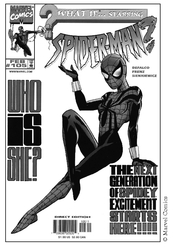
The problem?
There was no little girl.
As it turned out, the letter from the little girl was actually written by an older male fan, who wrote it from the perspective of his infant daughter, feeling that everything the little girl said in the letter would be what his daughter would think if she were given the chance to read Spider-Girl when she was older. While presumably annoyed, this new bit of news did not affect the reprieve, and Spider-Girl is still being published today (the first series ended, and it was relaunched as The Amazing Spider-Girl), with the reprint digest selling particularly well.


